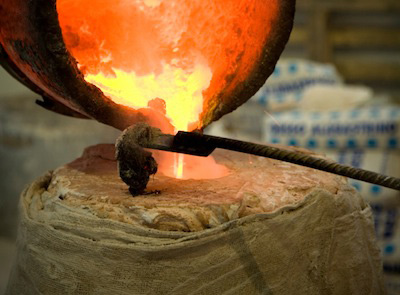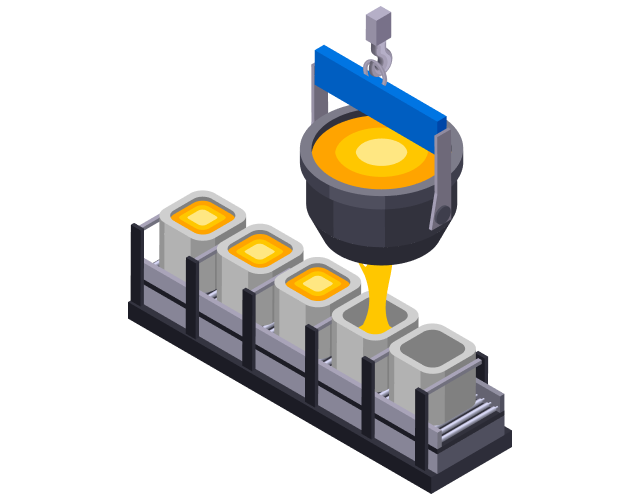Comprehending the Metal Castings Refine: A Comprehensive Overview for Beginners
The Metal Casting procedure is a fundamental method in manufacturing that changes molten metal right into solid types. Novices must comprehend the various techniques entailed, such as sand spreading and pass away casting. Recognizing the products, design concepts, and precaution is equally important. Each aspect plays a crucial function in achieving successful outcomes. As one navigates these complexities, the inquiry of how to maximize each step for improved outcomes comes to be significantly important.
The Fundamentals of Steel Casting
Metal Casting has actually developed over centuries, its fundamental concepts stay essential and regular to the manufacturing procedure. At its core, Metal Casting involves the makeover of liquified metal into solid objects with numerous techniques. The process starts with the creation of a mold, which defines the form of the end product. As soon as the mold is prepared, steel is heated up to its melting point and put into the cavity. After cooling, the steel solidifies, taking the form of the mold and mildew.
There are numerous casting approaches, consisting of sand casting, investment spreading, and pass away spreading, each with special benefits and applications. The selection of method depends upon factors such as production quantity, product kind, and desired precision. Once cast, the final item might undergo added processes like machining or surface area therapy to achieve the required surface and specifications. Comprehending these essentials is necessary for anyone interested in the field of Metal Casting.

Comprehending Products Utilized in Steel Casting
Products play a necessary role in the Metal Casting process, influencing the end product's properties and performance. Numerous metals are utilized, including light weight aluminum, bronze, steel, and iron, each offering distinct characteristics matched for specific applications. Aluminum is corrosion-resistant and lightweight, making it optimal for vehicle components. Iron, particularly cast iron, is favored for its outstanding wear resistance and resilience. Steel offers high stamina and convenience, often used in hefty equipment components. Bronze, recognized for its rust resistance and machinability, is typically used in marine applications.
Along with the steels, different casting materials, such as sand, plaster, and ceramic, are utilized to produce molds. Sand spreading, the most widespread technique, makes use of silica sand as a result of its thermal stability and ability to develop elaborate forms. Plaster and ceramic mold and mildews provide better details yet might need even more intricate procedures. The option of products straight impacts the performance, price, and top quality of the casting operation.
The Style Refine: From Idea to Plan
The design process in Metal Casting begins with the initial concept development, where concepts are produced and examined. This is followed by the application of CAD modeling strategies, allowing for precise visualizations of the layout. The blueprint completion steps guarantee that all requirements are precisely documented for production.
First Principle Development
First idea growth marks a critical phase in the Metal Casting procedure, where ideas transform into substantial designs. Throughout this stage, developers collaborate with stakeholders and engineers to brainstorm and refine initial principles. They think about factors such as functionality, appearances, and manufacturability, guaranteeing that the style satisfies the required requirements and efficiency requirements. Illustrations and rough drafts are developed to imagine the principles, enabling for preliminary analyses of feasibility and cost-effectiveness. This phase likewise entails identifying materials and possible casting methods that align with the design goals. Inevitably, initial idea development prepares for a comprehensive blueprint, guiding the succeeding stages of the casting process and ensuring a successful shift from concept to truth.
CAD Modeling Techniques
Transforming concepts right into accurate layouts, CAD modeling techniques play a pivotal role in the Metal Casting procedure. These strategies make use of advanced software application to produce detailed three-dimensional models that precisely show the designated product. By employing tools such as parametric modeling, solid modeling, and surface modeling, designers can control measurements and shapes easily. CAD systems likewise promote simulation and analysis, permitting the identification of potential flaws prior to manufacturing starts. This proactive method lowers material waste and enhances the design for manufacturability. Additionally, CAD designs can be quickly customized, allowing fast iterations based upon comments. Fundamentally, CAD modeling acts as the foundation of the design process, connecting the gap between initial principles and the ultimate production-ready layouts.
Plan Completion Tips
Following the production of thorough CAD models, the next phase entails blueprint completion, which is vital in translating digital layouts right into actionable plans for manufacturing. This procedure starts with examining the CAD models for accuracy and compliance with requirements. As soon as verified, the measurements, resistances, and material requirements are thoroughly detailed to assure quality. Incorporating notes and notes helps interact important information relating to spreading processes, surface coatings, and setting up requirements. The wrapped up plan undertakes a strenuous approval process, frequently including partnership with engineers and manufacturing teams to deal with any kind of possible problems. Revisions are made and approvals obtained, the plan is formally released, offering as the foundational record for the subsequent phases of Metal Casting, consisting of pattern making and mold layout.
The Metal Casting Methods Clarified

Metal Casting techniques include a selection of methods made use of to shape liquified metal right into desired kinds. These strategies differ according to the kind of material, complexity of the style, and production quantity. Sand casting is just one of the most typical approaches, including the creation of a mold from sand to hold the molten steel. Investment spreading, or lost-wax casting, permits complex designs by utilizing a wax pattern that is melted away. Pass away casting utilizes high-pressure shot of molten metal right into a mold and mildew, ideal for automation. Other techniques consist of permanent mold and mildew casting, which makes use of recyclable molds, and centrifugal spreading, where rotational forces help in loading the mold. Each strategy has its benefits and applications, making it important for producers to pick the proper method based on their certain demands and needs. Understanding these strategies is necessary for any individual involved in advice the Metal Casting process.
Finishing Processes: Enhancing Your Casted Item

Completing procedures play an essential role in enhancing the quality and look of casted items. Numerous surface area treatment techniques, such as polishing and layer, are employed to boost durability and visual appeals. In addition, high quality evaluation approaches assure that the end product fulfills defined standards and performance requirements.
Surface Treatment Methods
A variety of surface therapy techniques play a vital duty in improving the high quality and longevity of casted items. These strategies consist of techniques such as shot blasting, polishing, and covering. Shot blasting efficiently eliminates surface blemishes, boosting the practical and aesthetic features of the spreading. Polishing offers a smooth finish, which is particularly important for attractive applications and parts calling for marginal friction. Coating methods, such as electroplating or powder covering, deal extra protection against rust and wear, making certain sturdiness. Furthermore, surface treatments can boost adhesion for succeeding procedures, such as painting or bonding. By using these techniques, makers can attain exceptional surface quality, which is important for the efficiency and life-span of Metal Casting in different applications.
Quality Assessment Methods
Reliable quality assessment approaches are essential for ensuring the integrity and efficiency of casted items after the ending up processes. Various strategies are utilized to assess the top quality of Metal Casting, consisting of aesthetic inspection, dimensional checks, and non-destructive screening (NDT) Aesthetic examination allows for the recognition of surface area defects, while dimensional checks assure that products fulfill defined resistances. NDT approaches, such as ultrasonic screening and radiographic inspection, offer deeper understandings into inner stability without damaging the spreadings. In addition, mechanical screening, such as investigate this site tensile and solidity examinations, assesses product properties - Wisconsin Aluminum Foundry. By using a combination of these techniques, manufacturers can improve product high quality and integrity, ultimately resulting in better consumer satisfaction and minimized production costs
Security Considerations in Metal Casting
While the Metal Casting process supplies numerous benefits, it likewise presents a series of security dangers that have to be very carefully handled. Workers in casting centers are revealed to heats, molten metals, and hazardous products, which can lead to extreme injuries if appropriate safety measures are not taken. Personal protective equipment (PPE) such as heat-resistant handwear covers, encounter shields, and protective apparel is crucial to minimize risks.
Additionally, the visibility of fumes and dust demands proper ventilation systems to ensure air quality - Wisconsin Aluminum Foundry. Regular training on security methods is necessary for all workers to identify potential hazards and respond effectively. Emergency treatments should be developed, including fire security procedures and emergency treatment availability. Maintenance of equipment and correct handling of products even more add to a much safer working atmosphere. By focusing on these safety considerations, Metal Casting procedures can shield their workforce and keep reliable manufacturing procedures
Regularly Asked Questions
What Are the Ecological Effects of Metal Casting?
Metal Casting can cause ecological influences such go to website as air and water pollution, source exhaustion, and energy intake. Additionally, incorrect waste administration and discharges from shops contribute to environmental disturbances and health risks for neighboring neighborhoods.
Exactly how Do I Choose the Right Steel for Spreading?
To select the ideal metal for spreading, one need to consider elements such as mechanical homes, corrosion resistance, thermal conductivity, and cost. Evaluating the designated application and environmental conditions is important for ideal option.
What Are the Common Issues in Metal Casting?
Common defects in Metal Casting consist of porosity, shrinkage, sand addition, and misruns. These issues commonly develop from inappropriate material choice, inadequate style, or flaws in the casting procedure, impacting the end product's high quality and efficiency.
Just How Can I Boost My Steel Casting Skills?
To improve Metal Casting abilities, one ought to practice regularly, research study casting methods, examine previous tasks for flaws, seek feedback from seasoned wheels, and continuously explore various materials and methods to enhance efficiency and understanding.
What Is the Cost of Beginning a Metal Casting Company?
Beginning a steel casting service normally needs a first investment of $5,000 to $50,000, depending upon devices, materials, and facility costs. Factors like area and range can substantially influence overall start-up costs.
The Metal Casting procedure is an essential method in producing that transforms molten steel right into solid forms. Novices must grasp the numerous methods involved, such as sand casting and die spreading. There are numerous casting methods, consisting of sand casting, investment spreading, and pass away spreading, each with special advantages and applications. Investment casting, or lost-wax spreading, enables for intricate designs by using a wax pattern that is melted away. Other methods include permanent mold and mildew spreading, which utilizes multiple-use molds, and centrifugal spreading, where rotational forces aid in filling up the mold and mildew.